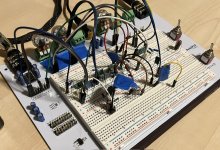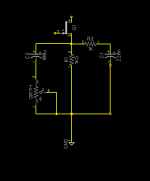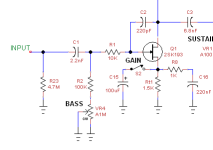Chuck D. Bones
Circuit Wizard
You may recall a contest I ran last year where I challenged the group to build a non-BMP circuit on a BMP board. Jason conjured up the FuzzDuster, an all-JFET BMP. Naturally, I had to breadboard it and then tweak it a bit. Fast-forward 18 months and I'm thinking about the FuzzDuster again. One of my first fuzzes was a borrowed BMP. The BMP was never one of my favorites, but I find myself drawn back to it. What can I do to make a BMP sound the way I want? Not so dense. Less noise. So I breadboarded the Fuzzduster once again and started making tweaks. With some input from Jason, here's where I ended up. Not nearly as much gain as a BMP, but enough for my purposes. The MODE switch add about 8dB more gain and fattens up the bottom-end a bit. Q2 runs without clipping diodes for a more open sound with less compression. Jason used JFETs wired as diodes for clipping. I use BA482s, which have a nearly identical V-I curve. The MID switch selects between a treble-cut tone control like in the BD-2 and a traditional BMP-style tone control. Back when I built my Ungula (EQD Hoof), I noticed that the clipping stages can be biased hotter (higher current) for a bit more gain without the transistors saturating. That's because the clipping diodes limit how far the collector (or drain in this case) voltage can swing. There are a lot of subtle differences in how the circuit operates when converting from BJTs to JFETs. The biasing is obviously different. There are no feedback resistors and the input impedance of each stage is very high. I dialed-in the bias on each stage by selecting JFETs and tweaking the source resistors. Many other JFETs will work, including J201 & 2N5246. You want something with a low Vp and Idss. All component values are negotiable. This circuit was optimized for Humbucker pickups, but works equally well with single-coils. If you want a fatter bottom-end, increase C3. Unlike the BMP, resistors R7, R12 and R16 do not affect the gain. They are there to prevent RF oscillation. The source resistors can be bypassed for a little more gain and tone-shaping. Q4's gain is set just below the clipping threshold, so I would not recommend increasing the gain of that stage.


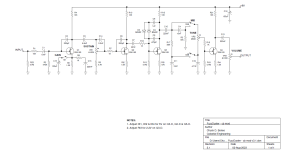
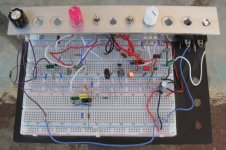
Last edited:


